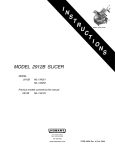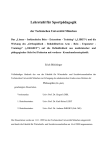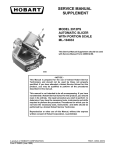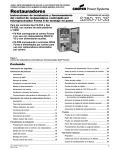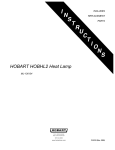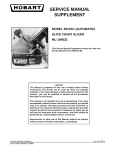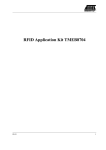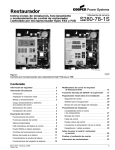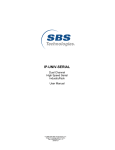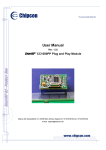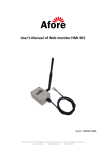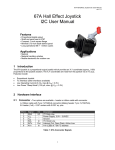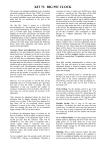Download SERVICE MANUAL SUPPLEMENT
Transcript
SERVICE MANUAL SUPPLEMENT Use this Service Manual Supplement in conjunction with Service Manual F24569 and Technical Service Bulletins 1053, 1054, 1064, 1078-A, 1096, 1105, 1113, and 1146. SLICER MODEL 2912B ML-134123 - NOTICE This Manual is prepared for the use of trained Hobart Service Technicians and should not be used by those not properly qualified. If you have attended a Hobart Service School for this product, you may be qualified to perform all the procedures described in this manual. This manual is not intended to be all encompassing. If you have not attended a Hobart Service School for this product, you should read, in its entirety, the repair procedure you wish to perform to determine if you have the necessary tools, instruments and skills required to perform the procedure. Procedures for which you do not have the necessary tools, instruments and skills should be performed by a trained Hobart Service Technician. Reproduction or other use of this Manual, without the express written consent of Hobart Corporation, is prohibited. A Product of Hobart Corporation TROY, OHIO 45374 F25103 (November 2001) 2912B SLICER TABLE OF CONTENTS GENERAL . . . . . . . . . . . . . . . . . . . . . . . . . . . . . . . . . . . . . . . . . . . . . . . . . . . . . . . . . . . . . . . . . . . . . . . . . . . . . Introduction . . . . . . . . . . . . . . . . . . . . . . . . . . . . . . . . . . . . . . . . . . . . . . . . . . . . . . . . . . . . . . . . . . . . . . . . . . Overview . . . . . . . . . . . . . . . . . . . . . . . . . . . . . . . . . . . . . . . . . . . . . . . . . . . . . . . . . . . . . . . . . . . . . . . . Appearance . . . . . . . . . . . . . . . . . . . . . . . . . . . . . . . . . . . . . . . . . . . . . . . . . . . . . . . . . . . . . . . . . . . . . . Electrical Features . . . . . . . . . . . . . . . . . . . . . . . . . . . . . . . . . . . . . . . . . . . . . . . . . . . . . . . . . . . . . . . . . Automatic Mode . . . . . . . . . . . . . . . . . . . . . . . . . . . . . . . . . . . . . . . . . . . . . . . . . . . . . . . . . . . . . . . . . . . Control Board . . . . . . . . . . . . . . . . . . . . . . . . . . . . . . . . . . . . . . . . . . . . . . . . . . . . . . . . . . . . . . . . . . . . . Tools . . . . . . . . . . . . . . . . . . . . . . . . . . . . . . . . . . . . . . . . . . . . . . . . . . . . . . . . . . . . . . . . . . . . . . . . . . . . . . . Basic Operation . . . . . . . . . . . . . . . . . . . . . . . . . . . . . . . . . . . . . . . . . . . . . . . . . . . . . . . . . . . . . . . . . . . . . . . Start Slicer . . . . . . . . . . . . . . . . . . . . . . . . . . . . . . . . . . . . . . . . . . . . . . . . . . . . . . . . . . . . . . . . . . . . . . . Pause Slicer (Automatic Mode Only) . . . . . . . . . . . . . . . . . . . . . . . . . . . . . . . . . . . . . . . . . . . . . . . . . . . Changing to Automatic While Operating in Manual Mode . . . . . . . . . . . . . . . . . . . . . . . . . . . . . . . . . . . . Stop Slicer . . . . . . . . . . . . . . . . . . . . . . . . . . . . . . . . . . . . . . . . . . . . . . . . . . . . . . . . . . . . . . . . . . . . . . . Returning Carriage Assembly to Home . . . . . . . . . . . . . . . . . . . . . . . . . . . . . . . . . . . . . . . . . . . . . . . . . . Reference Material . . . . . . . . . . . . . . . . . . . . . . . . . . . . . . . . . . . . . . . . . . . . . . . . . . . . . . . . . . . . . . . . . . . . 3 3 3 3 3 3 3 3 3 4 4 4 4 4 4 REMOVAL AND REPLACEMENT OF PARTS . . . . . . . . . . . . . . . . . . . . . . . . . . . . . . . . . . . . . . . . . . . . . . . . . Slicer Control Board Access . . . . . . . . . . . . . . . . . . . . . . . . . . . . . . . . . . . . . . . . . . . . . . . . . . . . . . . . . . . . . Slicer Control Board . . . . . . . . . . . . . . . . . . . . . . . . . . . . . . . . . . . . . . . . . . . . . . . . . . . . . . . . . . . . . . . . . . . Carriage Motor Relay (CMCR) . . . . . . . . . . . . . . . . . . . . . . . . . . . . . . . . . . . . . . . . . . . . . . . . . . . . . . . . . . . . Carriage Speed PCB Assembly . . . . . . . . . . . . . . . . . . . . . . . . . . . . . . . . . . . . . . . . . . . . . . . . . . . . . . . . . . . Speed/Position Assembly . . . . . . . . . . . . . . . . . . . . . . . . . . . . . . . . . . . . . . . . . . . . . . . . . . . . . . . . . . . . . . . Motor Start Switch Assembly . . . . . . . . . . . . . . . . . . . . . . . . . . . . . . . . . . . . . . . . . . . . . . . . . . . . . . . . . . . . . 5 5 6 6 7 7 7 SERVICE PROCEDURES AND ADJUSTMENTS . . . . . . . . . . . . . . . . . . . . . . . . . . . . . . . . . . . . . . . . . . . . . . . 9 Slicer Control Board LEDs . . . . . . . . . . . . . . . . . . . . . . . . . . . . . . . . . . . . . . . . . . . . . . . . . . . . . . . . . . . . . . . 9 Carriage Speed PCB Assembly . . . . . . . . . . . . . . . . . . . . . . . . . . . . . . . . . . . . . . . . . . . . . . . . . . . . . . . . . . . 9 Red LED Checks . . . . . . . . . . . . . . . . . . . . . . . . . . . . . . . . . . . . . . . . . . . . . . . . . . . . . . . . . . . . . . . . . . 9 Voltage Reading Checks . . . . . . . . . . . . . . . . . . . . . . . . . . . . . . . . . . . . . . . . . . . . . . . . . . . . . . . . . . . 10 Speed/Position Assembly . . . . . . . . . . . . . . . . . . . . . . . . . . . . . . . . . . . . . . . . . . . . . . . . . . . . . . . . . . . . . . 10 Yellow LED Checks . . . . . . . . . . . . . . . . . . . . . . . . . . . . . . . . . . . . . . . . . . . . . . . . . . . . . . . . . . . . . . . 10 Voltage Reading Check . . . . . . . . . . . . . . . . . . . . . . . . . . . . . . . . . . . . . . . . . . . . . . . . . . . . . . . . . . . . 11 Adjustment . . . . . . . . . . . . . . . . . . . . . . . . . . . . . . . . . . . . . . . . . . . . . . . . . . . . . . . . . . . . . . . . . . . . . . 11 Home Switch . . . . . . . . . . . . . . . . . . . . . . . . . . . . . . . . . . . . . . . . . . . . . . . . . . . . . . . . . . . . . . . . . . . . . . . . 12 Red LED Checks . . . . . . . . . . . . . . . . . . . . . . . . . . . . . . . . . . . . . . . . . . . . . . . . . . . . . . . . . . . . . . . . . 12 Continuity Check . . . . . . . . . . . . . . . . . . . . . . . . . . . . . . . . . . . . . . . . . . . . . . . . . . . . . . . . . . . . . . . . . 12 Start/Stop/Pause Switch . . . . . . . . . . . . . . . . . . . . . . . . . . . . . . . . . . . . . . . . . . . . . . . . . . . . . . . . . . . . . . . 12 Red LED Checks . . . . . . . . . . . . . . . . . . . . . . . . . . . . . . . . . . . . . . . . . . . . . . . . . . . . . . . . . . . . . . . . . 12 Voltage Reading Checks . . . . . . . . . . . . . . . . . . . . . . . . . . . . . . . . . . . . . . . . . . . . . . . . . . . . . . . . . . . 13 Interlock Switch (1LS) . . . . . . . . . . . . . . . . . . . . . . . . . . . . . . . . . . . . . . . . . . . . . . . . . . . . . . . . . . . . . . . . . 13 Checks . . . . . . . . . . . . . . . . . . . . . . . . . . . . . . . . . . . . . . . . . . . . . . . . . . . . . . . . . . . . . . . . . . . . . . . . . 13 Automatic/manual Switch (2S) . . . . . . . . . . . . . . . . . . . . . . . . . . . . . . . . . . . . . . . . . . . . . . . . . . . . . . . . . . . 14 Checks . . . . . . . . . . . . . . . . . . . . . . . . . . . . . . . . . . . . . . . . . . . . . . . . . . . . . . . . . . . . . . . . . . . . . . . . . 14 Lamp (1PL) . . . . . . . . . . . . . . . . . . . . . . . . . . . . . . . . . . . . . . . . . . . . . . . . . . . . . . . . . . . . . . . . . . . . . . . . . 14 Carriage Motor . . . . . . . . . . . . . . . . . . . . . . . . . . . . . . . . . . . . . . . . . . . . . . . . . . . . . . . . . . . . . . . . . . . . . . . 15 Checks . . . . . . . . . . . . . . . . . . . . . . . . . . . . . . . . . . . . . . . . . . . . . . . . . . . . . . . . . . . . . . . . . . . . . . . . . 15 ELECTRICAL OPERATION . . . . . . . . . . . . . . . . . . . . . . . . . . . . . . . . . . . . . . . . . . . . . . . . . . . . . . . . . . . . . . Component Function . . . . . . . . . . . . . . . . . . . . . . . . . . . . . . . . . . . . . . . . . . . . . . . . . . . . . . . . . . . . . . . . . . Start/Stop/Pause Switch (1S) . . . . . . . . . . . . . . . . . . . . . . . . . . . . . . . . . . . . . . . . . . . . . . . . . . . . . . . . Carriage Speed PCB Assembly . . . . . . . . . . . . . . . . . . . . . . . . . . . . . . . . . . . . . . . . . . . . . . . . . . . . . . Speed/Position Assembly . . . . . . . . . . . . . . . . . . . . . . . . . . . . . . . . . . . . . . . . . . . . . . . . . . . . . . . . . . . Slicer Control Board . . . . . . . . . . . . . . . . . . . . . . . . . . . . . . . . . . . . . . . . . . . . . . . . . . . . . . . . . . . . . . . Component Layout . . . . . . . . . . . . . . . . . . . . . . . . . . . . . . . . . . . . . . . . . . . . . . . . . . . . . . . . . . . . . . . . . . . Sequence of Operation . . . . . . . . . . . . . . . . . . . . . . . . . . . . . . . . . . . . . . . . . . . . . . . . . . . . . . . . . . . . . . . . Manual Sequence of Operation . . . . . . . . . . . . . . . . . . . . . . . . . . . . . . . . . . . . . . . . . . . . . . . . . . . . . . Conditions . . . . . . . . . . . . . . . . . . . . . . . . . . . . . . . . . . . . . . . . . . . . . . . . . . . . . . . . . . . . . . . . . . . . . . Automatic Sequence of Operation . . . . . . . . . . . . . . . . . . . . . . . . . . . . . . . . . . . . . . . . . . . . . . . . . . . . F25103 (November 2001) Page 2 of 24 16 16 16 16 16 16 16 18 18 18 18 2912B SLICER - GENERAL Pause Sequence of Operation . . . . . . . . . . . . . . . . . . . . . . . . . . . . . . . . . . . . . . . . . . . . . . . . . . . . . . . 18 Wiring Diagrams . . . . . . . . . . . . . . . . . . . . . . . . . . . . . . . . . . . . . . . . . . . . . . . . . . . . . . . . . . . . . . . . . . . . . 19 TROUBLESHOOTING . . . . . . . . . . . . . . . . . . . . . . . . . . . . . . . . . . . . . . . . . . . . . . . . . . . . . . . . . . . . . . . . . . 21 Manual Slicing . . . . . . . . . . . . . . . . . . . . . . . . . . . . . . . . . . . . . . . . . . . . . . . . . . . . . . . . . . . . . . . . . . . . . . . 21 Automatic Slicing . . . . . . . . . . . . . . . . . . . . . . . . . . . . . . . . . . . . . . . . . . . . . . . . . . . . . . . . . . . . . . . . . . . . . 22 CONDENSED SPARE PARTS LIST . . . . . . . . . . . . . . . . . . . . . . . . . . . . . . . . . . . . . . . . . . . . . . . . . . . . . . . . 24 © Hobart Corporation 2001 GENERAL Control Board INTRODUCTION Overview The 2912B is a 2000 Series based slicer that replaces the 2912SC for roast beef specific customers. Micro Ban technology is featured in all exposed plastic components. Appearance The outside appearance of the 2912B is very similar to the 2912 with only slight changes. • Heavier stainless steel meat grip arm. • Start/Stop/Pause and Automatic/Manual labels. Electrical Features Control board software controls the slice stroke speed. The software adjusts the slice stroke speed according to the load presented to the carriage assembly at any given time. This feature maintains a constant carriage speed as the load is lightened. Also, the carriage return stroke will be faster than the slice stroke by a proportion determined by the software. A feature unique to the 2912B is the use of three LEDs, (Green - Power, Yellow - Speed/Position, and Red - Diagnostic). LEDs are used as a diagnostic tool when troubleshooting the slicer. Information regarding the LEDs as a troubleshooting aid can be found in "SERVICE PROCEDURES AND ADJUSTMENTS". TOOLS Electrically, the 2912B features: • Slicer circuit board with on-board replaceable carriage motor relay (CMCR). • Enhanced software with start/pause circuitry in automatic mode. • Optical speed/position sensor for carriage speed control. • Loctite 242 - Threads securing bracket sensor. BASIC OPERATION In order for the 2912B to operate, certain conditions must be met before engaging Start/Stop/Pause switch. Automatic Mode • The 2912B can be started in either Automatic or Manual mode of operation. 1. Slicer must be plugged into appropriate power source. • Carriage speed is adjustable (6 speeds). Carriage movement is monitored by the speed/position assembly and control board. 2. Carriage assembly must be in "home" position. In Automatic mode start-up, the carriage motor begins driving the carriage assembly at half power until the control board senses the desired speed, load presented to the carriage, and carriage position in relation to home position. Once these factors are known, the control board sets the carriage motor to drive the carriage assembly at the correct speed. It takes two or three carriage stroke cycles to settle into the correct operating speed. NOTE: Carriage assembly is in home position when carriage is pulled nearest to operator controls. 3. Page 3 of 24 Gauge plate must be opened. F25103 (November 2001) 2912B SLICER - GENERAL 4. Pull Start/Stop/Pause switch out fully and release. A. Carriage motor starts. B. Carriage assembly moves according to speed selected. Stop Slicer Start Slicer NOTE: Slicer can be started in either Automatic or Manual mode. 1. Pull Start/Stop/Pause switch out fully and release. A. B. Push Start/Stop/Pause switch in fully. NOTE: When stopping the slicer in Automatic mode, the carriage assembly will stop in its present position unless the Start/Stop/Pause switch is first pulled OUT and released allowing the carriage assembly to return to home position. The carriage assembly must be returned to home position before slicer can be restarted. 1. Turn automatic lever to Manual. 1) 2. Pull carriage assembly to the home position (nearest operator controls). Knife motor starts. Automatic mode. 1) Knife motor starts. 2) Carriage motor starts. REFERENCE MATERIAL Carriage assembly moves according to speed selected. The 2912B can be serviced using 2912 Service Manual F-24569 for mechanical and adjustment procedures. Parts for the 2912B can be ordered using the 2912B Catalog of Replacement Parts F-43041. Information on components and parts unique to the 2912B can be found in this Service Manual Supplement. Pause Slicer (Automatic Mode Only) 2. 2. Manual mode. 3) Pull Start/Stop/Pause switch out fully and release. A. Close gauge plate. Returning Carriage Assembly to Home NOTE: It may take two or three slice strokes for the carriage motor to settle into the desired operating speed. 1. 1. Carriage assembly will finish the current slice cycle, slow on the return stroke, and stop in home position. To resume slicing, pull Start/Stop/Pause switch out fully and release. A. Carriage assembly will start moving at 1/2 power until control board adjusts for desired speed. Changing to Automatic While Operating in Manual Mode 1. Slicer operating in Manual mode. Carriage assembly in home position. NOTE: If carriage assembly is not in home position when automatic knob and lever is set to Automatic and Start/Stop/Pause switch is pulled out, knife motor will shut off. 2. Turn automatic lever to Automatic. 3. Set carriage speed control switch to desired speed. F25103 (November 2001) Page 4 of 24 2912B SLICER - REMOVAL AND REPLACEMENT OF PARTS REMOVAL AND REPLACEMENT OF PARTS NOTE: This section addresses the removal and replacement of components that are unique to the 2912B slicer. SLICER CONTROL BOARD ACCESS UPPER BASE AND AUTOMATIC BASE COMPONENT ACCESS WARNING: DISCONNECT THE MAIN POWER CORD. WARNING: DISCONNECT THE MAIN POWER CORD. CAUTION: Certain components in this system are subject to damage by electrostatic discharge during field repairs. A field service grounding kit is available to prevent damage. The field service grounding kit must be used anytime the control board is handled. 1. Perform "SLICER CONTROL BOARD ACCESS" as outlined in this section. 2. Remove bottom cover. 3. Remove the screws securing the speed/position sensor P-clips to upper base. 1. Push Start/Stop/Pause switch in to OFF position. 2. Close gauge plate. 3. Turn the automatic knob and lever to Manual. 4. Move carriage transport assembly to home position. 5. Remove "CARRIAGE TRAY ASSEMBLY". 6. Remove "KNIFE SHARPENER". NOTE: Make certain that sharpener handle is folded in to avoid breaking handle. Use a cloth or other cushioning material to protect slicer finish. 7. Turn slicer up and rest slicer on sharpener side of automatic base. 8. Remove the electrical cover assembly and position cover assembly to access slicer control board. NOTE: Remove slicer feet as required to access cap screws securing the automatic base to upper base. 4. Remove cap screws securing the automatic base to upper base. A. 5. Page 5 of 24 Separate automatic and upper bases. Reassemble in reverse order. F25103 (November 2001) 2912B SLICER - REMOVAL AND REPLACEMENT OF PARTS SLICER CONTROL BOARD WARNING: DISCONNECT THE MAIN POWER CORD. CAUTION: Certain components in this system are subject to damage by electrostatic discharge during field repairs. A field service grounding kit is available to prevent damage. The field service grounding kit must be used anytime the control board is handled. NOTE: All electrical connections are made through the slicer control board. The control board also houses a replaceable carriage motor relay (CMCR) and a set of three LEDs that can be used as a troubleshooting aid. The carriage motor relay, plug (*P), and junction (J*) locations are shown in the photos that follow. 1. 3. Remove nuts securing control board to electrical cover and remove control board. 4. Reassemble in reverse order. 5. Check for proper operation. CARRIAGE MOTOR RELAY (CMCR) Note locations and unplug all electrical connections on the slicer control board. WARNING: DISCONNECT THE MAIN POWER CORD. CAUTION: Exercise care when removing the carriage motor relay to avoid damage to the control board. NOTE: The carriage motor relay can be difficult to remove. Use care when removing relay from slicer control board. 2. 1. Perform "SLICER CONTROL BOARD ACCESS" as outlined in this section. 2. Carefully pry carriage motor relay from control board terminals. 3. Replace carriage motor relay. 4. Reassemble in reverse order, "SLICER CONTROL BOARD ACCESS" as outlined in this section. 5. Check for proper operation. Remove "CARRIAGE MOTOR RELAY (CMCR)" if it is to be reused on new slicer control board. F25103 (November 2001) Page 6 of 24 2912B SLICER - REMOVAL AND REPLACEMENT OF PARTS CARRIAGE SPEED PCB ASSEMBLY WARNING: DISCONNECT THE MAIN POWER CORD. 2. Disconnect speed/position assembly wiring plug 6P from slicer control board junction J6. 3. Remove screws securing speed/position assembly to automatic base and remove speed/position assembly. NOTE: If sensor vane is not being replaced, proceed to step 5. 4. 1. Perform "UPPER BASE AND AUTOMATIC BASE COMPONENT ACCESS" as outlined in this section. 2. Note location of carriage speed PCB assembly wires and disconnect wires. 3. Pull carriage speed PCB assembly knob from switch. 4. Unscrew nut and remove switch from base. 5. 6. Remove screws securing sensor vane and remove sensor vane. NOTE: Install sensor vane. Secure hardware using Loctite 242 on threads of screws. 5. Perform "SPEED/POSITION ASSEMBLY ADJUSTMENT" as outlined in "SERVICE PROCEDURES AND ADJUSTMENTS". Reassemble in reverse order. 6. Reassemble in reverse order. Check for proper operation. 7. Replace bottom covers. 8. Check for proper operation. SPEED/POSITION ASSEMBLY MOTOR START SWITCH ASSEMBLY WARNING: DISCONNECT THE MAIN POWER CORD. NOTE: The speed/position assembly is mounted to the automatic base with the sensor vane mounted to the main link assembly. WARNING: DISCONNECT THE MAIN POWER CORD. CAUTION: Make certain that the electric start switch (ESS) is connected correctly to the knife motor control board to prevent damage to the start windings of the knife motor. NOTE: Pay close attention to the orientation of the electric start switch (ESS) spade lugs with knife motor control assembly when removing connection assembly from the ESS and knife motor relay (KMCR). 1. 1. Perform "UPPER BASE AND AUTOMATIC BASE COMPONENT ACCESS" as outlined in this section. Perform "UPPER BASE AND AUTOMATIC BASE COMPONENT ACCESS" as outlined in this section. Page 7 of 24 F25103 (November 2001) 2912B SLICER - REMOVAL AND REPLACEMENT OF PARTS 2. Remove the upper electrical cover. NOTE: Before removing the knife motor control assembly, note pin orientation of ESS with relation to the knife motor control assembly. Make certain that the motor start switch assembly is installed so that wider spaced spade terminals of the ESS match the wider spaced terminal fittings on knife motor control assembly during reassembly. 5. 3. Remove knife motor control assembly from ESS. Note location of electrical wiring and disconnect wiring from knife motor control assembly. KNIFE MOTOR CONTROL ASSEMBLY 6. KNIFE MOTOR CONTROL ASSEMBLY 4. Remove screws securing motor start switch assembly to slicer base and remove motor start switch assembly with KMCR. If replacing KMCR, remove it from the knife motor control assembly. NOTE: The spacing difference between the narrow and wide terminals on the knife motor control assembly is very slight. To help in identifying the correct positioning of the ESS and knife motor control assembly terminals, refer to "COMPONENT LAYOUT" as outlined in "ELECTRICAL OPERATION". 7. Reassemble ESS and KMCR to knife motor control assembly. 8. Secure motor start switch assembly and KMCR to upper base of slicer. 9. Connect wiring harness, motor wires, and AC power wires to knife motor control assembly. 10. Reassemble upper electrical cover. 11. Reassemble in reverse order, "UPPER BASE AND AUTOMATIC BASE COMPONENT ACCESS" as outlined in this section. NOTE: The ESS and bracket make up the motor start switch assembly. It is not necessary to separate the ESS from the bracket. F25103 (November 2001) 12. Reassemble bottom covers. 13. Check for proper operation. Page 8 of 24 2912B SLICER SERVICE PROCEDURES AND ADJUSTMENTS SERVICE PROCEDURES AND ADJUSTMENTS WARNING: CERTAIN PROCEDURES IN THIS SECTION REQUIRE ELECTRICAL TEST OR MEASUREMENTS WHILE POWER IS APPLIED TO THE MACHINE. EXERCISE EXTREME CAUTION AT ALL TIMES. IF TEST POINTS ARE NOT EASILY ACCESSIBLE, DISCONNECT POWER, ATTACH TEST EQUIPMENT AND REAPPLY POWER TO TEST. CAUTION: Certain components in this system are subject to damage by electrostatic discharge during field repairs. A field service grounding kit is available to prevent damage. The field service grounding kit must be used anytime the control board is handled. SLICER CONTROL BOARD LEDS NOTE: The slicer control board LEDs are located on the right side of machine, under the carriage transport when transport is in home position, and underneath the slicer. The three LEDs can be viewed through three holes in the bottom electrical cover. NOTE: When gauge plate is closed and the Start/Stop/Pause switch is pulled out half way or fully, Red LED will flash three times then return to the 1 second rate. Under a heavy load and at a high speed setting, the Red LED may flash or go out. This happens only when full power is being applied to the carriage motor. CARRIAGE SPEED PCB ASSEMBLY (DC VOLTAGE) NOTE: The carriage speed PCB assembly can be checked either by observing the flash pattern of the Red LED, or by voltage readings. The carriage speed PCB assembly is a six position switch. Any change to the carriage speed control knob position will change the resistive value of the circuit. This change in resistance results in either a rise or fall of DC voltage across the carriage speed switch terminals. Green LED - Power LED that indicates 5 VDC is present for slicer control board electronic component operation. The Green LED is ON whenever the Start/Stop/Pause switch is in the run position (Start/Stop/Pause switch pulled half way out). Yellow LED - Driven by the optical sensor of the speed/position assembly and the sensor vane. The Yellow LED flashes at a variable rate depending on the speed of the carriage transport assembly. Essentially, the Yellow LED is ON when the sensor vane blocks the optical sensor light, and OFF when the light from the optical sensor is allowed to pass through the sensor vane. When the carriage drive linkage is in home position the sensor vane will block the optical sensor light. Red LED - Diagnostic LED that flashes at a 1 second rate when Start/Stop/Pause switch is pulled half way out. Red LED is ON constantly whenever knife motor is running. NOTE: The speed control switch can be checked in manual or automatic mode without the knife motor running. Red LED Checks 1. Place carriage assembly in home position. 2. Place reflective material (mirror or clean putty knife) under slicer to observe the LEDs. 3. Turn carriage speed control switch to the LOW position, fully counterclockwise. 4. Pull Start/Stop/Pause switch out half way to run position. Page 9 of 24 F25103 (November 2001) 2912B SLICER SERVICE PROCEDURES AND ADJUSTMENTS 5. Verify that the Green LED is ON constantly, and the Red LED is flashing at a 1 second rate. 6. Turn the carriage speed control switch one position clockwise while observing the flash pattern of the Red LED. With meter on DC setting, place COM meter lead on pin J7-1 and Red meter lead on pin J7-2 and observe meter reading. A. Three quick flashes then a return to the 1 second rate indicates that the switch is operating normally. 1) B. Repeat the Red LED test for all switch positions. NOTE: Knife motor should not be running. E. Measured voltage across these points should be 5 VDC. Voltage Reading Checks 1. Perform "SLICER CONTROL BOARD ACCESS" as outlined in "REMOVAL AND REPLACEMENT OF PARTS". 2. Connect slicer to power source. 3. Turn carriage speed PCB assembly knob to the LOW position (fully counterclockwise). 4. With the meter on DC setting, place COM meter lead on J7-1 and Red lead on J7-2 while 2P is connected to J7 on the control board. 5. Pull Start/Stop/Pause switch out half way to run position. SPEED/POSITION ASSEMBLY (DC VOLTAGE) NOTE: Knife motor should not be running. 6. 7. Verify that the Green LED is ON constantly, and the Red LED is flashing at a 1 second rate. Observe meter reading and refer to table below for each position/voltage value. NOTE: A flashing Yellow LED in automatic mode indicates a functioning speed/position assembly. Knob Position DC Voltage Ohms 1 5.0 - 0.5V Open ( ) (LOW, CCW) 2 4.0 ± 0.5V 8.87k 3 3.0 ± 0.5V 3.27k 4 2.0 ± 0.5V 1.47k 5 1.0 ± 0.5V 560 6 0.0 + 0.5V 0.0 (HI, CW) Yellow LED Checks The carriage speed PCB assembly is checked by observing the flashing rate of the Yellow (center) LED, and by voltage readings. NOTE: A change of voltage for each switch position indicates a normally functioning switch. To check resistance, disconnect power to slicer and unplug 2P from J-7. Measure resistance across 2P terminals 1/2. 8. If voltage reading is 0.0 VDC or near zero at slowest setting (full CCW): A. Push Start/Stop/Pause switch IN to turn power off. B. Remove meter leads from J7-1 and J7-2. C. Unplug 2P from J7 on control board. D. Pull Start/Stop/Pause switch out half way. F25103 (November 2001) WARNING: THE SLICER KNIFE IS VERY SHARP. EXERCISE EXTREME CAUTION WHEN WORKING NEAR THE KNIFE. 1. Open gauge plate. 2. Place carriage assembly in home position. 3. Turn carriage speed control switch to the LOW position (fully counterclockwise). 4. Turn automatic lever to Automatic. 5. Place reflective material (mirror or clean putty knife) under slicer to observe the Yellow (center) LED. 6. Turn slicer ON by pulling the Start/Stop/Pause switch out fully and releasing. NOTE: The knife motor should be running and carriage assembly should be moving. 7. Page 10 of 24 Verify that the Green and Red LEDs are ON constantly and the Yellow LED is flashing. 2912B SLICER SERVICE PROCEDURES AND ADJUSTMENTS NOTE: The Yellow LED will flash at a variable rate in relation to the speed at which the carriage assembly is moving. Placing a load on the carriage assembly (holding onto the carriage handle) will slow the carriage assembly movement enough to see a change in the Yellow LED flash rate. EXAMPLE: LOW speed selected and a load on the carriage assembly will result in a noticeable on/off LED flashing rate. However, with HI speed selected and no load on carriage assembly, the Yellow LED will be flashing rapidly - flickering, almost appearing to be on constantly. Voltage Reading Check 1. Perform "SLICER CONTROL BOARD ACCESS" as outlined in "REMOVAL AND REPLACEMENT OF PARTS". NOTE: Sensor vane is properly adjusted when the sensor vane travels in the approximate middle of the optical sensor for the entire travel path of the carriage transport assembly. Pay close attention to the ends of sensor vane as optical sensor contact (interference) is most likely to occur at these points. 2. Unplug plug 6P from junction J6. 3. 3. Connect slicer into power source. 4. Pull Start/Stop/Pause switch out half way. 5. With meter on DC setting, place COM meter lead on J6-2 and RED meter lead on J6-1. 6. Verify that 5VDC is present across terminals J6-1 and J6-2. NOTE: If the Yellow LED does not light at all, check slicer control board J6 output voltage. Loosen screws securing sensor vane to main link assembly. NOTE: Apply Loctite 242 to sensor vane screws before adjusting and securing sensor vane to main link assembly. A. Adjustment WARNING: DISCONNECT THE MAIN POWER CORD. Adjust sensor vane/optical sensor clearance by reforming the sensor vane or by moving sensor vane in or out to position sensor vane within the approximate center of the optical sensor for the entire range of main link travel. CAUTION: The optical sensor of the speed/position assembly can be damaged if the sensor vane is not first properly aligned with the speed/position assembly before operating slicer. 1. Perform "UPPER BASE AND AUTOMATIC BASE COMPONENT ACCESS" as outlined in "REMOVAL AND REPLACEMENT OF PARTS". 2. Disconnect motor drive link assembly from main link assembly and carriage drive motor. NOTE: When viewing the sensor vane through the inspection holes, the sensor vane should pass under the center of both inspection holes. B. Page 11 of 24 Move main link assembly back and forth the full travel range while observing the sensor vane/optical sensor clearance through the inspection holes. F25103 (November 2001) 2912B SLICER SERVICE PROCEDURES AND ADJUSTMENTS 5. Place reflective material (mirror or clean putty knife) under slicer to observe the Red LED. 6. Pull Start/Stop/Pause switch out half way to run position. NOTE: Knife motor should not be running. 4. Tighten sensor vane screws and recheck sensor vane adjustment. Readjust if necessary. 7. Verify that the Green LED is ON constantly and the Red LED is flashing at a 1 second rate. 8. Move carriage assembly away from home position while observing the Red LED flash pattern. NOTE: Three quick flashes of the Red LED then a return back to the 1 second flash rate indicates that the home position switch is operating. NOTE: Make certain that plug 6P is connected to junction J6 on the control board. 9. Return carriage assembly to home position while observing the Red LED flash pattern. 5. Position slicer control board to view LEDs. NOTE: The Red LED should repeat the 3 quick flashes then return to a 1 second flash rate. 6. Connect slicer into power source. 7. Pull Start/Stop/Pause switch out half way to run position. 8. Verify that the Green LED is ON constantly. 9. Manually move main link assembly through full travel range. Continuity Check 10. Verify that the Yellow LED flashes ON and OFF as sensor vane passes through optical sensor of speed/position assembly. WARNING: DISCONNECT THE MAIN POWER CORD. 1. Perform "SLICER CONTROL BOARD ACCESS" as outlined in "REMOVAL AND REPLACEMENT OF PARTS". 2. Disconnect plug 1P from junction J1 on the control board. 3. 11. Disconnect power to slicer. With meter set to resistance (), place meter leads across 1P2-9 and 1P2-10. 12. Reconnect motor drive link assembly to main link assembly. A. 13. Reassemble in reverse order "UPPER BASE AND AUTOMATIC BASE COMPONENT ACCESS" as outlined in "REMOVAL AND REPLACEMENT OF PARTS". B. A. In home position. 1) Move carriage assembly away from home position. 1) Reassemble bottom covers. 14. Check for proper operation. Resistance reading should be 0.0 ohms. Resistance reading should be infinite resistance (open circuit). START/STOP/PAUSE SWITCH (AC VOLTAGE) HOME SWITCH NOTE: The home switch can be checked either by observing the flash pattern of the Red LED, or by a continuity check. Red LED Checks NOTE: A change in the Red LED flash pattern indicates a functioning home switch. NOTE: Both start/pause and run positions of the Start/Stop/Pause switch can be checked either by observing the flash pattern of the Red LED, or by voltage readings. Red LED Checks 1. Close gauge plate. NOTE: A change in the Red LED flash pattern indicates a functioning Start/Stop/Pause switch. 2. Place carriage assembly in home position. 1. Close gauge plate. 3. Push Start/Stop/Pause switch in fully to OFF position. 2. Place carriage assembly in home position. 3. 4. Turn automatic lever to Manual. Push Start/Stop/Pause switch in fully to OFF position. F25103 (November 2001) Page 12 of 24 2912B SLICER SERVICE PROCEDURES AND ADJUSTMENTS 4. Place reflective material (mirror or clean putty knife) under slicer to observe the Red LED. 5. Observe the LEDs while pulling Start/Stop/Pause switch out half way to run position. 6. Verify that the Green LED is ON constantly and the Red LED flashed 3 times quickly then changed to flashing at a 1 second rate. B. Start/Stop/Pause switch pulled out fully and held out (contacts closed). Measured voltage across J1-5 and J1-1 should be the line voltage (120 VAC). INTERLOCK SWITCH (1LS) NOTE: Knife motor will continue to run as long as Start/Stop/Pause switch is held out fully. 7. Pull Start/Stop/Pause switch out fully and release while observing the LEDs. 8. Verify that the Red LED flash pattern changed to three quick flashes and then returned to the 1 second flash rate. WARNING: DISCONNECT THE MAIN POWER CORD. WARNING: THE SLICER KNIFE IS VERY SHARP. EXERCISE EXTREME CAUTION WHEN WORKING NEAR THE KNIFE. NOTE: The interlock switch cannot be checked using the slicer control board LEDs. Because of slicer control board circuitry, a continuity check is used to check the interlock switch. Voltage Reading Checks Checks 1. Turn index knob to below "0" position (closed position). 1. 2. Perform "SLICER CONTROL BOARD ACCESS" as outlined in "REMOVAL AND REPLACEMENT OF PARTS". Perform "SLICER CONTROL BOARD ACCESS" as outlined in "REMOVAL AND REPLACEMENT OF PARTS". 2. Disconnect plug 1P from junction J1. 3. 3. Connect slicer to power source. 4. Verify that line voltage is present to slicer control board terminals J4/J5 (Hot) and J2/J3 (Neutral). On-Off Section of Switch (N.O. Contacts) 1. 2. 4. Turn index knob counterclockwise to open gauge plate while observing meter reading. 5. Measure resistance. With meter on AC setting, place COM meter lead on terminal J1-5 (Neutral) and Red on J1-3 while plug 1P is connected to J1. A. A. B. Measured voltage should be the line voltage (120VAC). Gauge plate open. 1) Resistance should be 0.0 ohms. Gauge plate closed. 1) Move Red meter lead to J1-4. A. 3. With meter set to measure resistance (), place meter leads across terminals 1P-7 and 1P-8. Resistance reading should be infinite resistance (open circuit). Measured voltage should be approximately 0.0 VAC. Pull Start/Stop/Pause switch out half way to the run position (1S contacts 1/4 closed). A. Measured voltage across J1-5 and J1-4 should be the line voltage (120VAC). Start/Pause Section of Switch (Momentary) 1. With meter on AC setting, place meter lead across terminals J1-5 (Neutral) and J1-1 while plug 1P is connected to J1. 2. Measure voltage. A. Start/Stop/Pause switch in run (half way out) position. Measured voltage across J1-5 and J1-1 should be approximately 0.0 VAC. NOTE: Knife motor will continue to run as long as Start/Stop/Pause switch is held out fully. Page 13 of 24 F25103 (November 2001) 2912B SLICER SERVICE PROCEDURES AND ADJUSTMENTS AUTOMATIC/MANUAL SWITCH (2S) LAMP (1PL) - (AC VOLTAGE) WARNING: THE SLICER KNIFE IS VERY SHARP. EXERCISE EXTREME CAUTION WHEN WORKING NEAR THE KNIFE. WARNING: DISCONNECT THE MAIN POWER CORD. NOTE: The automatic/manual switch (2S) is a SPDT switch with J7-5 being the common terminal. This switch cannot be checked using the slicer control board LEDs. Due to the slicer control board circuitry, switch (2S) is checked by making a continuity check. 1. Perform "SLICER CONTROL BOARD ACCESS" as outlined in "REMOVAL AND REPLACEMENT OF PARTS". 2. Open gauge plate. 3. With meter on AC setting, place meter leads across J1-5 and J1-6 while 1P is connected to J1. 4. Connect slicer to power source. 5. Pull Start/Stop/Pause switch out fully and release. Checks 1. Perform "SLICER CONTROL BOARD ACCESS" as outlined in "REMOVAL AND REPLACEMENT OF PARTS". 2. Reinstall carriage assembly. 3. Set meter to resistance () to check continuity. NOTE: Knife motor should be running. 6. Testing N.O. Contacts 4. Automatic knob and lever set to Manual. 5. Unplug 2P from J7. 6. Place meter leads across 2P-5 and 2P-4. A. Resistance should be 0.0 ohms. B. Keeping meter leads on 2P-5 and 2P-4, set automatic knob and lever to Automatic. 1) Resistance across 2P terminals 5/4 should be infinite resistance (open circuit). Testing N.C. Contacts 7. Set automatic lever to Automatic. 8. Place meter leads across 2P-5 and 2P-3. A. Resistance should be 0.0 ohms. B. Keeping meter leads on 2P-5 and 2P-3, set automatic lever to Manual. 1) Resistance across 2P terminals 5/3 should be infinite resistance (open circuit). F25103 (November 2001) Page 14 of 24 Measured output voltage should be the line voltage (120 VAC). 2912B SLICER SERVICE PROCEDURES AND ADJUSTMENTS CARRIAGE MOTOR (DC VOLTAGE) WARNING: THE SLICER KNIFE IS VERY SHARP. EXERCISE EXTREME CAUTION WHEN WORKING NEAR THE KNIFE. NOTE: Output voltage to carriage motor varies with carriage speed selected. Voltage to carriage motor is lowest when speed select knob is at the LOW setting (counterclockwise) and highest with speed select knob set to HI setting (clockwise). Checks 1. Perform "SLICER CONTROL BOARD ACCESS" as outlined in "REMOVAL AND REPLACEMENT OF PARTS". 2. Open gauge plate. 3. Set automatic lever to Automatic. 4. With meter on DC setting, place COM meter lead on J7-6 and RED meter lead on J7-7 while 2P is connected to J7. 5. Connect slicer to power source. 6. Pull Start/Stop/Pause switch out fully and release to start slicer in automatic mode of operation. 7. Measure carriage motor voltage. A. B. If carriage assembly does not move and measured voltage is within the range of 50VDC to +120VDC, check: 1) Motor windings. 2) Motor brushes. 3) Related wiring. If measured voltage is approximately 0.0 VDC: 1) With meter set on AC, place COM lead on J1-5 and RED lead on J7-8. Measure voltage. a. If 120VAC is present, slicer control board has malfunction. b. If 120VAC is not present, check CMCR or circuit breaker. Page 15 of 24 F25103 (November 2001) 2912B SLICER - ELECTRICAL OPERATION ELECTRICAL OPERATION COMPONENT FUNCTION NOTE: Only features and components unique to the 2912B slicer are listed in this supplement. For a full component function list, refer to the 2912 Service Manual. Start/Stop/Pause Switch (1S) . . . . . Three position switch which controls the electrical power to two slicer control board triacs. Motor starts when operational conditions are met and the Start/Stop/Pause switch is pulled fully out. A spring mechanism, internal to the Start/Stop/Pause switch, will return the Start/Stop/Pause switch to the run position when the knob is released. Carriage Speed PCB Assembly . . . Selects speed of carriage speed motor. Speed/Position Assembly . . . . . . . . Monitor for speed and position of the carriage assembly’s automatic drive linkage. Knife Motor Control Assembly . . . . Connection board between the knife motor relay, electric start switch, and wiring (motor and harness). Slicer Control Board . . . . . . . . . . . . Controls automatic and manual electrical operations of the slicer through the mircocontroller. Determines speed and position of the carriage assembly in automatic mode. Monitors and reports conditions of control board voltage and carriage speed/position in automatic mode of operation through the use of Green and Yellow LEDs. On board Red diagnostic LED displays functionality of carriage speed PCB assembly, Start/Stop/Pause switch, and home switch by using a flash code. COMPONENT LAYOUT F25103 (November 2001) Page 16 of 24 2912B SLICER - ELECTRICAL OPERATION Page 17 of 24 F25103 (November 2001) 2912B SLICER - ELECTRICAL OPERATION B. SEQUENCE OF OPERATION KMCR - Knife motor control relay. CMCR - Carriage motor control relay. Manual Sequence of Operation 1. Conditions A. Correct voltage supplied to slicer. B. Automatic knob and lever in Manual position. 1) 2LS N.O. contacts closed. C. Carriage tray assembly in home position. 1) Home Switch N.O. contacts closed. D. Circuit breaker (1 CB) operating normally (contacts closed). E. Gauge plate closed. 1) Interlock switch 1LS contacts open. F. Start/Stop/Pause switch in OFF position (Start/Stop/Pause switch pushed in fully). 1) 1S N.O. contacts 1/4 and 1S N.O. momentary contacts 2/3 are closed. 2. Open gauge plate. A. Interlock switch 1LS contacts close. 3. Start/Stop/Pause switch pulled out fully to start position. A. 1S N.O. contacts 1/4 and 1S N.O. momentary contacts 2/3 close. B. Home triac gated ON. 1) KMCR coil energizes. a. KMCR N.O. contacts 8/6 close. b. KMCR N.O. contacts 2/4 close. 2) Pilot light energized. C. AUTO off triac gated ON. 1) Knife motor latching circuit energized. D. ESS energized. 1) Knife motor operates. 4. Start/Stop/Pause switch (1S) is released to run (half way out) position. A. 1S momentary N.O. contacts 2/3 open. 1) Home triac de-energizes. 5. Knife motor operates through latching circuit until: A. Start/Stop/Pause switch (1S) is pushed in to OFF position. 1) 1S N.O. contacts 1/4 open. B. Gauge plate is closed 1) Interlock switch (1LS) is open. Automatic Sequence of Operation 1. Conditions same as manual. 2. Automatic knob and lever set to Automatic. A. 2LS C/N.C. contacts closed. 3. Gauge plate opened. A. Interlock 1LS N.C./C closed. 4. Start/Stop/Pause switch pulled out fully to start position. A. 1S N.O. contacts 1/4 and momentary contacts 2/3 close. F25103 (November 2001) Home triac gated ON. 1) CMCR energized. a. N.O. contacts 2/4 close. b. N.O. contacts 6/8 close. 2) KMCR energizes. a. N.O. contacts 8/6 close. b. N.O. contacts 2/4 close. 3) Pilot light energizes. C. Automatic off triac gates ON. 1) Latching circuit to KMCR energizes. D. ESS energized. 1) Knife motor operates. E. Bridge rectifier supplies DC to carriage motor. F. Carriage speed triac gated ON - controls DC voltage to carriage motor. 5. Start/Stop/Pause switch (1S) is released to run (half way out) position. A. 1S momentary N.O. contacts 2/3 open. 1) Home triac gated off. 6. Knife and carriage motor operate until: A. Start/Stop/Pause switch (1S) is pushed in to OFF position. 1) 1S N.O. contacts 1/4 open. B. Gauge plate is closed. 1) 1LS NC/C contacts open. C. Circuit Breaker (1CB) opens. 1) Carriage motor stops running. 2) Knife motor continues to run. D. Start/Stop/Pause switch (1S) is pulled out fully to initiate pause sequence. Pause Sequence of Operation 1. Condition - Slicer operating in Automatic mode. 2. Start/Stop/Pause switch (1S) is pulled out fully and released while slicer is operating in automatic mode. A. Slicer control board slows carriage motor on return slice stroke preparing to stop in home position. B. Slicer control board gates AUTO off triac to off condition. C. KMCR coil de-energizes. 1) KMCR N.O. contacts 2/4 and 6/8 open. a. KMCR and CMCR circuits unlatch and knife motor stops running respectively. D. CMCR coil de-energizes. 1) CMCR N.O. contacts 6/8 and 2/4 open. a. Carriage motor stops. 3. Start/Stop/Pause switch (1S) is pulled out fully and released. A. Repeats steps 2 through 5 of "AUTOMATIC SEQUENCE OF OPERATION". Page 18 of 24 2912B SLICER - ELECTRICAL OPERATION WIRING DIAGRAMS Page 19 of 24 F25103 (November 2001) 2912B SLICER - ELECTRICAL OPERATION F25103 (November 2001) Page 20 of 24 2912B SLICER TROUBLESHOOTING TROUBLESHOOTING MANUAL SLICING 1. Slicer connected to voltage specified on data plate. 2. Gauge plate opened. 3. Carriage assembly is in home position. 4. Automatic/Manual switch set to Manual. 5. Start/Stop/Pause switch pulled out fully and released. SYMPTOM Knife motor does not run. (Pilot light does not light). 1. NOTE: Knife motor may hum if certain components are 2. inoperative. 3. Knife motor does not run. (Pilot light lit). Knife motor starts slow or starts backwards. Start/Stop/Pause switch (1S) inoperative. Home position switch open. 4. Magnet weak or missing. (Carriage transport). 5. Auto/Man switch (2LS) inoperative. 6. KMCR inoperative. 7. Knife motor control assembly malfunction. 8. 1. Slicer control board malfunction. Electronic start switch malfunction (motor may hum). NOTE: Knife motor may hum if certain components are 2. inoperative. Knife motor will only run with Start/Stop/Pause switch held out fully. POSSIBLE CAUSE No power to slicer. KMCR inoperative. 3. Capacitor inoperative (motor may hum). 4. 1. Knife motor is inoperative (motor may hum). Gauge plate not open. 2. Gauge plate interlock switch (1LS) inoperative. 3. Auto/Man switch (2S) is inoperative. 4. KMCR contacts 2/4 inoperative. 1. Electronic start switch malfunction. 2. Capacitor inoperative. Page 21 of 24 F25103 (November 2001) 2912B SLICER TROUBLESHOOTING AUTOMATIC SLICING NOTE: Make sure that the knife motor runs in manual slice mode before proceeding. If not, trouble shoot from manual slicing chart. 1. Slicer connected to voltage specified on data plate. 2. Gauge plate opened24. 3. Carriage assembly is in home position. 4. Automatic knob and lever set to Automatic. 5. Start/Stop/Pause switch pulled out fully and released. SYMPTOM Knife motor does not run in Automatic. Knife motor runs. 1. 1. POSSIBLE CAUSE Auto/Man switch (2LS) inoperative. Circuit breaker (1CB) tripped. (Carriage drive motor does not operate). 2. Auto/Man (2LS) inoperative. 3. CMCR inoperative. 4. Carriage drive motor inoperative. Cannot change speed of carriage drive motor. 5. 1. Slicer control board malfunction. Carriage speed PCB assembly inoperative. (Pause feature operates normally). Cannot change speed of carriage drive motor. 2. 1. Slicer control board malfunction. Speed/Position assembly inoperative. (Pause feature does not operate normally. Carriage assembly at times stops away from home position). 2. Sensor vane blocked or missing. 3. Slicer control board malfunction. F25103 (November 2001) Page 22 of 24 2912B SLICER - NOTES - Page 23 of 24 F25103 (November 2001) 2912B SLICER CONDENSED SPARE PARTS LIST CONDENSED SPARE PARTS LIST 2912B SLICER Part No. Description 873630 Carriage Speed PCB Assembly 873633 Slicer Control PCB Board 873643 Speed/Position Assembly 873638 Sensor Vane 438929 Motor Start Switch Assembly 87714 -42-1 Relay (2 pole) 873635 Knife Motor Control PCB Assembly F25103 (November 2001) Printed in U.S.A.
























